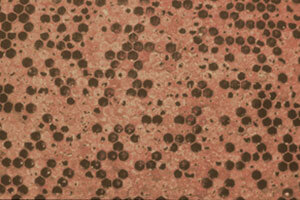
Before the advent of the Varroa bee mite (Varroa destructor), the biggest challenge to honey bee health was American foulbrood (AFB), caused by the rod-shaped spore-forming bacterium Paenibacillus larvae (formerly classified as Bacillus larvae and Paenibacillus larvae ssp larvae/pulvifaciens). It is the most widespread and destructive of the brood diseases, according to Wikipedia.com: “Larvae up to three days old become infected by ingesting spores present in their food. Young larvae less than 24 hours old are most susceptible to infection. Spores germinate in the gut of the larva and the vegetative bacteria begin to grow, taking nourishment from the larva. Spores will not germinate in larvae over three days old. Infected larvae normally die after their cell is sealed. The vegetative form of the bacterium will die, but not before it produces many millions of spores. American foulbrood spores are extremely resistant to desiccation and can remain viable for more than 40 years in honey and beekeeping equipment. Each dead larva may contain as many as 100 million spores.”
A paper in the 2010 Journal of Invertebrate Pathology provides a history of this fearsome disease: “By 1650 nearly all farms in New England are reported to have had a colony or two of bees. However, the number of bees managed by these colonists rapidly declined after 1670, presumably because of AFB. Substantive documentation of AFB’s presence in the new world, however, did not occur until more than a century later, by the late 1800s and early 1900s. Then, AFB and EFB were a ‘veritable scourge’ in many parts of the country resulting in the passage of many state bee laws and implementation of state apiary inspection programs. These early apiary laws proposed to mitigate the spread of AFB by requiring the destruction of all infected colonies and the burning of infected bee equipment. This effort was not insignificant, for instance, in the state of Pennsylvania over 32,000 colonies were burned between 1930 and 1965, a number that is just shy of the total number of colonies in the state in 2007 according to the Ag Census (PA Dept of Ag, unpublished records; USDA-NASS, 2009c).”
The discovery of antibiotics, materials that stopped vegetative reproduction in a bacteria’s life cycle, has been a boon to humans themselves, as well as their animal husbandry activities. The application of these substances in beekeeping hailed the beginning of honey bee “domestication.” The evolution of treatments includes Sulfathiazole®, a so-called “sulfa” drug (1940s-1950s), followed by oxytetracycline, a broad spectrum tetracycline, Terramycin® (1950s through 1990s). Lincomycin, Lincomix® and more recently tylosin tartrate, Tylan® have all allowed beekeepers to use them to prevent reproduction of the vegetative stage. Unfortunately, these substances are not effective against the spores of Paenibacillus larvae, which represent the biggest challenge to controlling AFB. They are literally indestructable, except by fire and radiation, and can exist almost indefinitely as disease “time bombs” in honey, ready to germinate when liberated through honey-bee-feeding activity.
Beekeepers often have not realized the potential “inconvenient” results of using these antibiotics. Sulfa drugs have mostly been abandoned because of their potential to contaminate honey. The others have been relatively inexpensive and easy to acquire for use in various treatments from dusts, to liquids to something called “extender patties.” The latter provide an extremely long-lasting treatment by mixing the antibiotic in vegetable shortening. However, it is now well known that once use begins, it must continue. AFB simply patiently waits in its spore form to begin growing anew. In addition, these materials have been readily available “over the counter” in several formulations, many of which are then further re-formulated by enterprising beekeepers to use in a “prophylactic,” or preventative manner, keeping AFB at bay, but not eradicating it. Unfortunately, just as their other animal agriculturalist cousins have realized, the continuous use of any one antibiotic over time by beekeepers all too often results in resistance by bacteria, which can evolve into more potent organisms in the long run.
AFB Resistance to antibiotics has indeed been identified in many countries, including the U.S., Canada and perhaps most spectacularly, Argentina. It is now apparent that overuse of antibiotics in both human health and agriculture is leading to a “perfect storm,” which many have called a future disaster of great proportion. The bottom line so far is that these “wonder” substances that have furthered treatment for so many diseases could be rendered useless, with little if any backup substance in the research and/or distribution pipeline to replace them.
Another risk, more specific to beekeeping, is the possibility of contaminating the honey crop with antibiotics. This was expressed by C.L. Farrar as far back as 1960 in American Bee Journal – vol. 100 – Number 5 – May, 1960, pages 192, 193:
“The beekeeper must recognize that Federal food-additive laws now in effect apply to honey as well as all …


